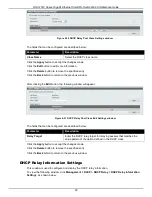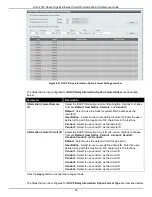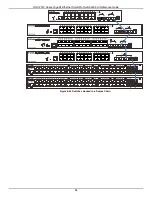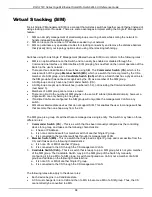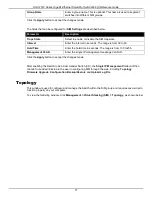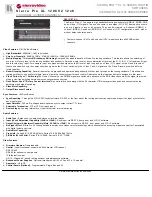
DGS-1510 Series Gigabit Ethernet SmartPro Switch Web UI Reference Guide
66
Master if the Backup Master is promoted to the Primary Master, or if the Backup Master fails or is
removed from the switch stack. If both Primary and Backup masters fail, or are removed from the Switch
stack, it will determine if it is to become the Primary Master. These roles will be determined, first by
priority and if the priority is the same, the lowest MAC address.
Once switches have been assembled in the topology desired by the user and powered on, the stack will
undergo three processes until it reaches a functioning state.
Initialization State
– This is the first state of the stack, where the runtime codes are set and initialized
and the system conducts a peripheral diagnosis to determine each individual switch is functioning
properly.
Master Election State
– Once the codes are loaded and initialized, the stack will undergo the Master
Election State where it will discover the type of topology used, elect a Primary Master and then a Backup
Master.
Synchronization State
– Once the Primary Master and the Backup Master have been established, the
Primary Master will assign Stacking Unit IDs to switches in the stack, synchronize configurations for all
switches and then transmit commands to the rest of the switches based on the users configurations of the
Primary Master.
Once these steps have been completed, the switch stack will enter a normal operating mode.
Stack Switch Swapping
The stacking feature of the Switch supports “hot swapping” of switches in and out of the running stack.
Users may remove or add switches to the stack without powering down or largely affecting the transfer of
data between switches in the stack, with a few minor provisions.
When switches are “hot inserted” into the running stack, the new switch may take on the Primary Master,
Backup Master or Slave role, depending on configurations set on the newly added switch, such as
configured priority or MAC address. Yet, if adding two stacks together that have both previously
undergone the election process, and therefore both have a Primary Master and a Backup master, a new
Primary Master will be elected from one of the already existing Primary Masters, based on priority or MAC
address. This Primary Master will take over all of the Primary Master’s roles for all new switches that were
hot inserted. This process is done using discovery packets that circulate through the switch stack every
1.5 seconds until the discovery process has been completed.
The “hot remove” action means removing a device from the stack while the stack is still running. The hot
removal is detected by the stack when it fails to receive heartbeat packets during its specified interval
from a device, or when one of the stacking ports links is down. Once the device has been removed, the
remaining switches will update their stacking topology database to reflect the change. Any one of the
three roles, Primary Master, Backup Master or Slave, may be removed from the stack, yet different
processes occur for each specific device removal.
If a Slave device has been removed, the Primary Master will inform other switches of the hot remove of
this device through the use of unit leave messages. Switches in the stack will clear the configurations of
the unit removed, and dynamically learned databases, such as ARP, will be cleared as well.
If the Backup Master has been hot removed, a new Backup Master will be chosen through the election
process previously described. Switches in the stack will clear the configurations of the unit removed, and
dynamically learned databases, such as ARP, will be cleared as well. Then the Backup Master will begin
backing up the Primary Master when the database synchronization has been completed by the stack.
If the Primary Master is removed, the Backup Master will assume the Primary Master’s role and a new
Backup Master will be chosen using the election process. Switches in the stack will clear the
configurations of the unit removed, and dynamically learned databases, such as ARP, will be cleared as
well. The new Primary Master will inherit the MAC and IP address of the previous Primary Master to avoid
conflict within the stack and the network itself.
If both the Primary Master and the Backup Master are removed, the election process is immediately
processed, and a new Primary Master and Backup Master are determined. Switches in the stack will clear
the configurations of the units removed, and dynamically learned databases, such as ARP, will be cleared
as well. Static switch configurations still remain in the database of the remaining switches in the stack and
those functions will not be affected.
Summary of Contents for DGS-1510 Series
Page 1: ...1...


